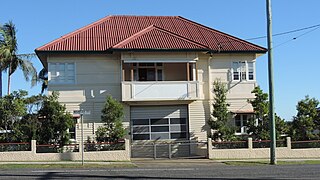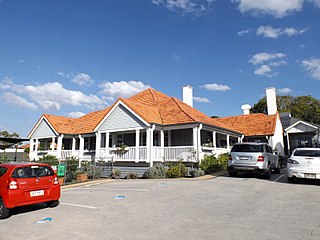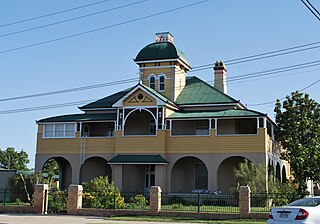
Lady Bowen Hospital is a heritage-listed former maternity hospital and now social housing and office complex at 497–535 Wickham Terrace, Spring Hill, City of Brisbane, Queensland, Australia. It was designed by John H. Buckeridge and built from 1889 to 1890 by John Quinn. It was also known as Brisbane Lying-In Hospital and the Lady Bowen Hostel. It was added to the Queensland Heritage Register on 23 April 1999. The complex consists of the former hospital and nurses' quarters buildings; a third building which had been contained in the heritage listing was demolished c. 2005–2008.

Toowoomba Hospital is a heritage-listed hospital at Pechey Street, Toowoomba, Toowoomba Region, Queensland, Australia. It was built from c. 1880 to c. 1927. It is also known as Toowoomba Base Hospital. It was added to the Queensland Heritage Register on 28 July 2000.

Toowoomba Police Station Complex is a heritage-listed police station at 50-52 Neil Street, Toowoomba, Queensland, Australia. It was designed by Raymond Clare Nowland and built in 1935. It was added to the Queensland Heritage Register on 5 October 1998.

Brisbane School of Arts is a heritage-listed school of arts at 166 Ann Street, Brisbane City, City of Brisbane, Queensland, Australia. It was built from 1865 to 1985. It is also known as former Servants Home. It was added to the Queensland Heritage Register on 21 October 1992.

Wynnum Ambulance Station is a heritage-listed museum and former ambulance station at 33 Tingal Road, Wynnum, City of Brisbane, Queensland, Australia. It was built from 1926 to 1927. It is also known as the Queensland Ambulance Museum and the QATB Station. It was added to the Queensland Heritage Register on 26 March 1999. It is open by appointment.

Wynnum Fire Station is a heritage-listed former fire station at 39 Mountjoy Terrace, Wynnum, City of Brisbane, Queensland, Australia. It was designed by Atkinson & Conrad and built from 1922 to 1938. It was added to the Queensland Heritage Register on 28 May 1999.

Albion Fire Station is a heritage-listed former fire station at 42 Bridge Street, Wooloowin, City of Brisbane, Queensland, Australia. It was designed by Department of Public Works and built from 1925 to 1927. It was added to the Queensland Heritage Register on 28 February 2003.

Nundah Fire Station is a heritage-listed former fire station at 7 Union Street, Nundah, City of Brisbane, Queensland, Australia. It was designed by Atkinson & Conrad and built in 1936 by T F Woollam. It was added to the Queensland Heritage Register on 26 March 1999.

Lyndhurst is a heritage-listed villa at 3 London Road, Clayfield, City of Brisbane, Queensland, Australia. It was designed by Robin Dods and built from 1896 onwards by Walls & Juster. It is also known as The Reid House. It was added to the Queensland Heritage Register on 12 December 2003.

St Mary's Presbytery is a heritage-listed Roman Catholic presbytery of St Mary's Roman Catholic Church at 142 Palmerin Street, Warwick, Southern Downs Region, Queensland, Australia. It was designed by Wallace & Gibson and built from 1885 to 1887 by John McCulloch. It is also known as Father JJ Horan's private residence. It was added to the Queensland Heritage Register on 31 July 2008.

Rockton is a heritage-listed villa at Rockton Street, Newtown, City of Ipswich, Queensland, Australia. It was built from 1855 onwards. It was added to the Queensland Heritage Register on 21 October 1992.

Gympie Ambulance Station is a heritage-listed ambulance station at 17 Crown Road, Gympie, Queensland, Australia. It was built in 1904. It was added to the Queensland Heritage Register on 16 September 2011.

Criterion Hotel is a heritage-listed hotel at 98 Wharf Street, Maryborough, Fraser Coast Region, Queensland, Australia. It was designed by James Robertson and built from 1878 to 1883 by the Cooper Brothers. It is also known as Melbourne Hotel and Riverview Hotel. It was added to the Queensland Heritage Register on 21 October 1992.
Post Office Hotel is a heritage-listed hotel at Bazaar Street, Maryborough, Fraser Coast Region, Queensland, Australia. It was designed by Victor Emmanuel Carandini and built in 1889 by Mr Murray. It was added to the Queensland Heritage Register on 21 October 1992.

Maryborough Base Hospital is a heritage-listed hospital at Walker Street, Maryborough, Fraser Coast Region, Queensland, Australia. It was designed by Queensland Colonial Architect John James Clark and built from 1887 by Robert Taylor. It is also known as Maryborough General Hospital. It was added to the Queensland Heritage Register on 2 February 1998.

Hotel Childers is a heritage-listed hotel at 59 Churchill Street, Childers, Bundaberg Region, Queensland, Australia. It was built from c. 1895 to 1930s. It is also known as Queen's Hotel. It was added to the Queensland Heritage Register on 21 October 1992.

Childers Ambulance Station is a heritage-listed former ambulance station at 69 Churchill Street, Childers, Bundaberg Region, Queensland, Australia. It was designed by Leonard Kempster and built in 1924 by Queensland Department of Public Works. It is also known as Childers QATB and Isis District Centre QATB. It was added to the Queensland Heritage Register on 21 October 1992.

Yungaba is a heritage-listed villa at 74 Ward Street, The Range, Rockhampton, Rockhampton Region, Queensland, Australia. The design is attributed to James Flint and it was built from 1890 to 1950s. It was added to the Queensland Heritage Register on 24 March 2000. Although originally constructed as a private residence, it was known as "Yungaba Migrant Hostel" during its use as a migrant hostel in the 1950s.
The WH Paxton & Co. Buildings are a heritage-listed group of offices and warehousing at 10 River Street, Mackay, Mackay Region, Queensland, Australia. The 1899 sections were designed by Mackay architect Arthur Rigby and constructed by Charles Porter and Joseph Vidulich (warehouse). The 1912 warehouse extension was designed by Brisbane architect Montague Talbot Stanley. It was added to the Queensland Heritage Register on 14 August 2008.

Ambulance Building is a heritage-listed former ambulance station and now museum at 157 Gill Street, Charters Towers City, Charters Towers, Charters Towers Region, Queensland, Australia. It was designed by Walter Hunt and built in 1903 by Arthur Reid and James Walker. It is also known as Ambulance Building (former). It was added to the Queensland Heritage Register on 4 December 2015.




















